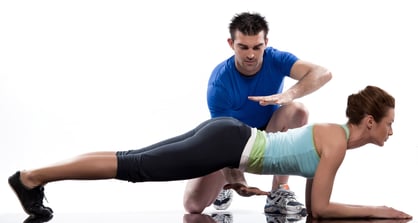How to Integrate MAT® Into Personal Training
Before diving into the details about integrating Muscle Activation Techniques® (MAT) into personal training, let's go back and recap the MAT thought process and the practical application of Muscle Activation Techniques.
MAT teaches that bilateral assessments related to a client's range of motion will help to identify limitations in their range of motion and that any limitations are indications that one or more muscles crossing the axis of  that position aren't functioning properly.
that position aren't functioning properly.
If a limitation is identified, MAT teaches its students to follow the "limited side" and then begin a series of very specific tests that can help the practitioner evaluate what specific positions (and the specific muscle(s)) contribute to movement into and out of this position may not be functioning properly. If it is discovered that muscles aren't functioning properly MAT teaches two different methods for activating those muscles.
Lastly, and possibly most importantly, MAT is one of the few modalities that allow practitioners to "check their work". This means that the certified MAT practitioner will go back to the specific positional test that was administered prior to the activation technique and see if the muscles ability to contract (or sustain the pressure applied by the practitioner) is improved over the prior test.
Typically, a series of these events leads to the client's bilateral range of motion becoming more symmetrical. Having this recap fresh in mind helps give you context to how we recommend Personal Trainers (with an MAT Specialist Certification) can integrate MAT into their client's personal training sessions.
Personalized Exercise
Here are 5 reasons why Muscle Activation Techniques allows certified MAT practitioners who are also certified personal trainers to bring better results to their clientele and provide a more personal exercise experience!
1.) Start each session with a check-in/check-up on how the client is feeling and do stability and mobility assessments prior to loading them with weight or complex movement activities.
This aspect gives true meaning to the title "personal" trainer. You will be able to help provide your client with a bit more of an understanding of why they may be feeling imbalances in their range of motion or why they may be feeling "unstable" during certain movements.
After you have uncovered the cause of instability through very specific range of motion assessments and positional muscle tests, you will be able to address it and help correct it with prescriptive positional iso-angular contractions (we call them "PIC's"... a precise activity most similar to isometrics), to ensure the client is prepared for their training session with loaded weight or increased joint motion.
2.) Clients can do these isometrics at home.
The MAT PICs are low impact and can be done daily to help build more stability through ranges of motion by improving the client's muscle contractile efficiency. You will be able to give clients these exercises that are specific to their problems to do before a home workout or before a weekend activity to ensure their bodies are prepared for athletic performance!
This can also leave the client with a sense of commitment and ownership that they are taking control of their bodies and how they want to feel pre and post-activity. Even some of the best personal trainers could utilize this tip for an at-home program for their clientele!
3.) You are able to check in with your client after the session to ensure everything is still mobile and stable after the workout.
Throughout the workout, you have placed stresses on your client's body and you need to make sure they leave feeling better than when they came in. That doesn't only mean a confidence boost! You want them leaving feeling strong, energized, and hopefully pain free!
This is particularly important for client retention because if you can get them feeling good, looking good, and help to decrease or even eliminate the aches and pains that come with training, then you have a client for life!
4.) Help identify what may be causing your client's pain.
This point is HUGE and here's why: You may have experienced injuries yourself, whether they are major or minor, you know that coming back from an injury can be very difficult mentally and physically!
Being able to tell your clients that you are seeing a limitation in their right hip internal rotation is a great insight for a customer. This might get them to draw correlations between this limitation and possible causes of their knee pain after doing squats or a long day of skiing.
Any time a personal trainer can help a client understand their body and its stress threshold, it is a distinctly advantageous service! By identifying and helping to correct your client's limitations they will be able to protect and prepare themselves for activities outside of your training sessions and hopefully restart or continue to participate in the things they love. In today's world stress takes on many forms.
With MAT, you as a trainer will better understand and approach the human body knowing that stress can be physical, mental, and emotional and that breakdowns in the muscular system can come from any and all of the above stresses.
5.) Customize each session based on your client's needs that day!
Not only will you be able to individualize a training program for your client based on their specific limitations, but if your client is in need of some time off you will have the tools to use that time to put your client back together.
It is easy to forget, but recovery days are equally as important as training days!
As we all know each client has a different structure, different movement patterns, different ranges of motion, and that structure requires individual care and attention and with MAT you will be equipped to provide meaningful assistance to any body and every body!
Interested in learning how to become MAT certified? Let's get connected!